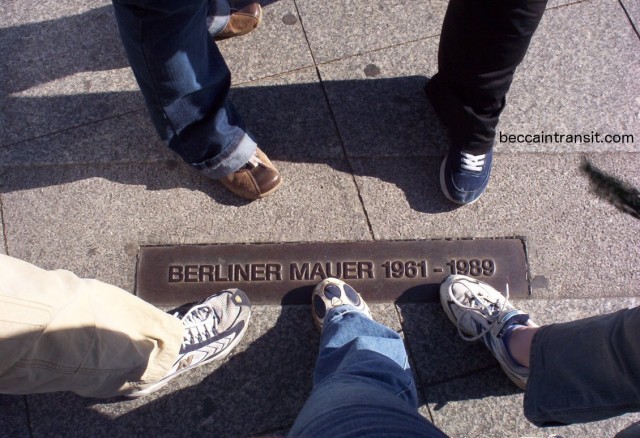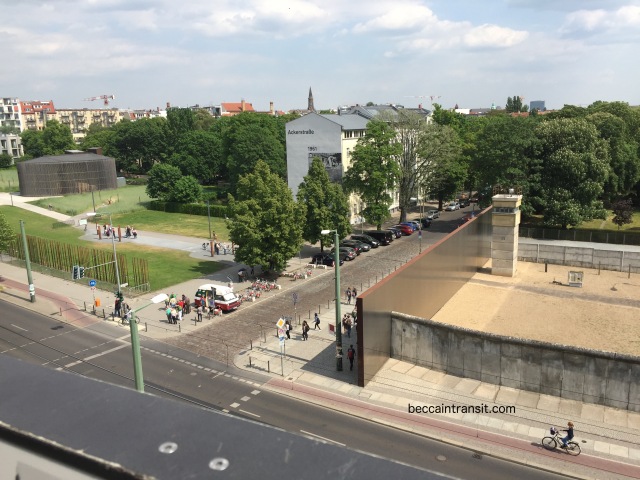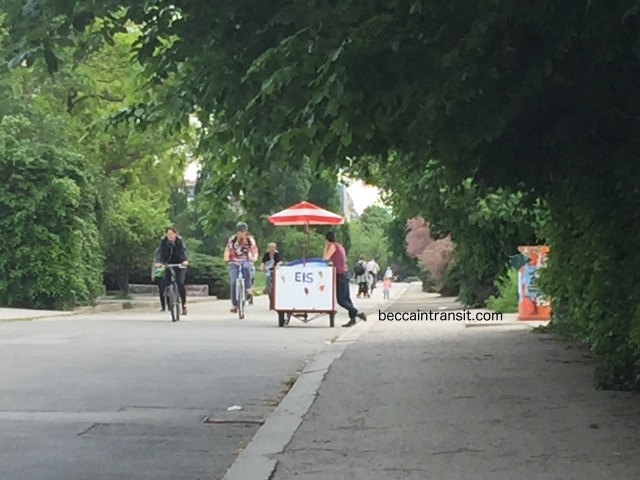As a big fan of thrift stores and ApartmentTherapy.com, I love seeing how people make something beautiful out of what was once far from it. To understand where I’m coming from, please bear with a bit of a world history lesson, then a personal history reflection, before I get into the Death Strip.
History Lesson
After World War 2, the Allies divvied up Germany into what historians call Spheres of Influence, responsible for rebuilding and rejuvenating their respective spheres of the nation they had just defeated. Geographically appropriately, Russia took the eastern sphere. Not just the nation itself, but on a smaller scale, its capitol city too, were divided into four.
During one summer night in 1961, Soviet soldiers rolled out bales of barbed wire along their borders with the other three spheres, and residents woke up the next morning to find they were no longer free to move about their own city. Worse: because Berlin was in the greater Soviet sphere of Germany, this meant that the British, French, and US spheres—”West Berlin”—were completely walled-in.
Over time, the barbed wire surrounding West Berlin was replaced by wire fencing, then a concrete wall, then improvements to the concrete wall (higher, more difficult to climb), before, in 1989, peaceful protests (and a lot of other political things) managed to bring it down.
In its last iteration, the Berlin Wall actually consisted of two walls flanking a sort of no-man’s land called the Death Strip, maybe half the width of a city block or more, with guard dogs and guard towers and—on the Western side anyway—covered in what’s now become iconic graffiti.
Okay, Back to Me
I first visited Berlin in June 2001, and bits of the wall still stood everywhere. Protesters handed out flyers with slogans like “Preserve the wall!” and my friends and I laughed about how the same people 12 years earlier had wanted nothing more than to tear the thing down.
But then I returned in 2004, and the wall was gone.

Strips in the sidewalk now mark where it stood.
And it makes sense. On the one hand, the wall was a symbol of division, of fear, of hatred. That wall kept families in the same city separated for 28 years.
But on the other hand, those who don’t know the past are doomed to repeat it, so no one is served by pretending it never happened.
So What Were You Saying About Beauty?
As I’m sure you could imagine, the Death Strip left quite a gash through the city. But over time, that gash was replaced by buildings, by weeds, by ideas. And now, part of it has been transformed into the Mauerpark (Wall Park) and the Gedenkstätte Berliner Mauer (Berlin Wall Memorial).
What I love about the memorial is that it includes photos on the sides of buildings—buildings designed with no windows overlooking the memorial, lest East Berliners use them to escape—photos that show that city block during the history of the wall.

Excuse the wobbliness. I’m kind of bad at iPhone panos.
It leaves the erstwhile Death Strip open so visitors can see how wide it is. It marks the path of underground tunnels escapees dug with various levels of success. It even leaves part of the Death Strip looking much as it did even as recently as the year I was born.

All that green on the left used to be Death Strip. During most of the late 20th century, it looked more like it does on the right.
This land was once a site of turmoil and sorrow. At least 138 people died trying to cross into West Berlin. And we forget that to our shame and our detriment. But by transforming parts of the Death Strip into a park and a memorial, Berlin has managed to memorialize the past while still looking forward into a brighter future.

Nothing’s more unifying than ice cream and bike paths.
7/29/16 Edit I just finished A Concise History of Germany, by Mary Fulbrook, and realized I’ve been conflating the formation of East and West Berlin with the building of the Berlin Wall when really, the political split had happened as early as the late 1940s. To quote Fulbrook:
In January 1947 the British and American zones had fused to become a ‘Bizone’. . . . The French . . . were eventually brought into co-operation with the British and Americans. . . . [and] the Federal Republic of Germany was formally founded in May 1949. . . . In large measure as a direct response, the German Democratic Republic was formally founded in the Soviet zone a few months later, in October 1949. (p. 211–212)
I’m sorry for misleading you on this topic above!



Wonderful post
LikeLiked by 1 person
Thank you so much! Berlin always inspires me.
LikeLike
Ive always read that Germany was divided into 2…thanks for sharing info about the other 2 spheres too
LikeLiked by 1 person
That’s great! I love getting to share cool history.
LikeLiked by 1 person
Always interesting and love your writing. No matter what the subject you keep me reading! Thanks for sharing!
LikeLike
Thanks, Janie!
LikeLike